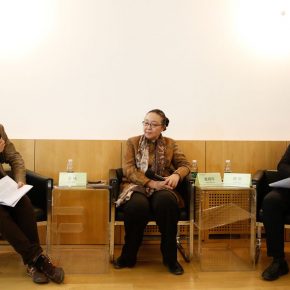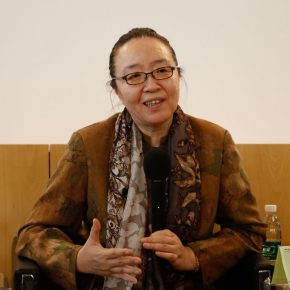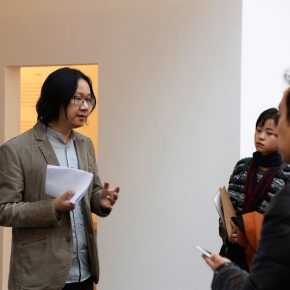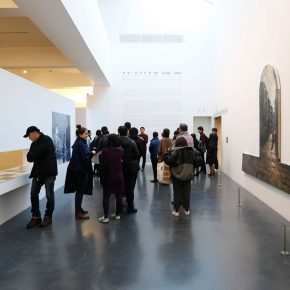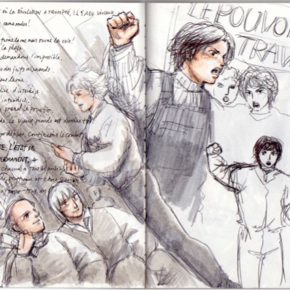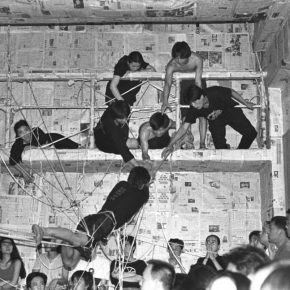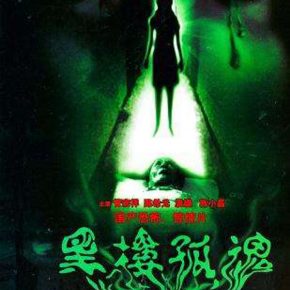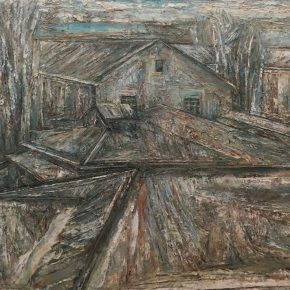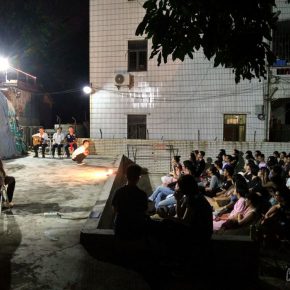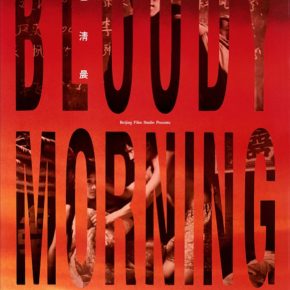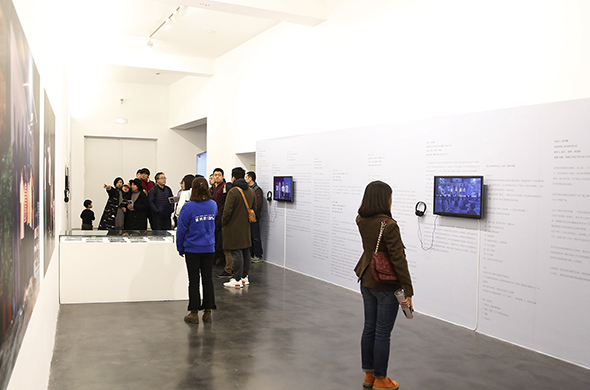
The horror film “The Lonely Spirit in an Old Building” which was shot in 1989 is being screened in the exhibition hall of the Inside-Out Art Museum. It is a story about an old building in which a filmmaker, together with?an?actress recorded sound?for a film, and then a series of strange events occurred?in the building. The actress, who has a special ability to see the past, found a murder case that had happened in this building during the “Cultural Revolution.” The female ghost took the US banknotes as bait to avenge the perpetrator who killed her. This story of the film integrates politics, revolution, desires?and capital, in the end, it was turned into a story that a group of mental health patients talked about in a hospital. In the end, a nurse said “It is time to take medicine” that also explains the confused and absurd cognition of a specific value system. “The Lonely Spirit in an Old Building” is a prelude to the “The Lonely Spirit” presented at the Inside-Out Art Museum, this encourages thinking?on the formation of mainstream values in China since the 1990s.
“The Lonely Spirit” kicked off on 18 November 2018. It was jointly curated by Prof. Dai Jinhua from the Institute of Comparative Literature and Comparative Culture in Peking University and the senior curator of Inside-Out Art Museum Su Wei. Director of Inside-Out Art Museum Carol Yinghua Lu delivered a speech at the opening ceremony and said that, domestic and international peers have always looked down on Chinese problems, and also, the status quo of thinking and practices happening in China which were ignored, the Inside-Out Art Museum launched a series of events and exhibitions on “China As a Problem”. It is necessary to start?from the local, exploring specific problems, facing reality and problems in China, finding suitable methods, to re-examine the source of our experiences and the process of formation, and explores a variety of self-expressions. “The Lonely Spirit”?returns to the historical scene, highlighted the “mainstream value” in the field of literature and art, observed the position of literature and art and the granted value, as well as the efforts of countless individuals in the process of new China’s development, and also it offers a slice that allows people to learn how the culture and role shared by the creation and productive forms that have changed, how the inner driving force and sense of questioning were enhanced, and what kind of dialogue continues with an authoritative object.
Centered on examining the “mainstream value”, it focuses on a variety of cultural practices including visual arts. The so-called contemporary art is juxtaposed with other artistic creations and productive forms in the exhibition, to jointly create a sample slice for people to?reflect?on the past. The latter includes but is not limited to theater, documentaries, films, internet culture, subcultures, literature, and debates on thought. In seven chapters of the exhibition, “Prelude: The Lonely Spirit in An Old Building”, “The Other Shore: Experimental Theatre, New Documentary and the Sixth Generation Film”, “Off the Shore: Urban Film”, “Sex/Politics: Literature”, “Divide: Intellectual History in the 1990s”, “Rear-view Mirror: Legacy and Translation”, “Condensing Lens: Reification in New Realities” and “Parallel Universes”, it looks at the 1990s and the last couple of years in the new millennium.
It starts with the horror film of “The Lonely Spirit in An Old Building”,?also entitled “The Lonely Spirit”. “The Other Shore: Experimental Theatre, New Documentary and the Sixth Generation Film” presents several pioneering dramas and films created in the 1990s. Among them, it presents an experimental drama, directed by Mou Sen in 1993, “The Other Shore/Discussion on Chinese Grammar of the Other Shore”, in which students struggled and climbed using?intertwined ropes and shouted: “Urgently, we have to cross the river and reach the other shore!” It creates a discussion on the meaning of “the other shore”, and also suggests that people try to reach “the other shore” which might not be beautiful, but one will reach?“the other shore” only if the problem of reality is solved. “Off the Shore: Urban Film” uses films to tell the spiritual value of a generation, among them “After Separation” tells a story of a man and a woman who secretly fell in love with each other in the course of living alone in?China after they respectively sent their lovers overseas. Also it is a story about “off the shore.” “Sex/Politics: Literature” presents the writing of sex in Wang Xiaobo’s book “Golden Age”, Tie Ning’s “Rose Gate”, Lao Gui’s “Bloody Dusk”, Cui Zi’en’s “Enter the Clowns”, and it suggests that: the writing of sex in literature was finally visible at the turn of the 1980s and 1990s, exposed among the screams and whispers covered by an invisibility mist,?and becomes a resounding cultural echo of the historic turn of Chinese society. At the same time, “Divide: Intellectual History in the 1990s” focused on the debates on the “spirit of humanities”, “new left”, and “l(fā)iberalism”, published by the magazines and journals such as “Xue Ren/Scholars”, “Du Shu/Reading” and “Tian Ya”. The scholar Wang Hui’s article “Contemporary Chinese Ideological Status and Modernity” which has caused a widespread discussion is also displayed in this part. “Rear-view Mirror: Legacy and Translation” mainly displays the works by?Zhao Dajun, Li Dafang and Liu Ding, to showcase the thoughts left and stimulated by historical and cultural problems. Historic ruins are also the places?of freedom?of the mind. “Condensing Lens: Reification in New Realities” has returned to the film and the theater media, among?which a?series of dramas entitled “Our Stories”?were created and performed by?the?workers from Shenzhen. The scripts were diverted from life, and they perform a view of the real and true life. “Parallel Universes” highlights subcultures, such as the “Les miserable” adapted and created by Hu Wei on the basis of a Japanese comic book of the same name, and it finished a transformation of multiple identities and perspectives: from literary scholars to fan-fiction creators, from the authors of original fictions about boys’ love of the authors of the fan-fiction images, from the traditional, icon-like aesthetic to the tendency embracing the revolution and progressivism.
Closely?associated with our thoughts and behaviors, mainstream values?are presented?in a complex form within the cognitive relationship of social individuals. As the background suggested by the exhibition: For Chinese society and its cultural reality at the turn of the twenty-first century, to be able to identify the mainstream value serves as the key to the understanding of Chinese culture, including its artistic representations, its shifting taste as well as its conceptual coordinates. However, there is still very little agreement concerning what mainstream value is, how many variations exist, and what they can do. Mainstream values have to stay plural when it comes to contemporary China. Also, “Imagining” is?juxtaposed with?“Mainstream Value”?in order to emphasize the imagination that has been functioning on a different layers?since the turn of the new century. Confrontations with the mainstream values—perceptible within a certain range—are generally represented as tragic to a degree, yet such representations are responsible for the negligence of a few important cultural facts. Indeed, the sea change of Chinese society over the past four decades takes place not because a completely planned power structure had commanded so, yet it could not have happened had the authority not conceded to the “elbow room”. Therefore, how do we think about mainstream values in Chinese cultural environment and how do we coexist with mainstream values??The curator, Prof. Dai Jinhua believes that mainstream values are not simply focusing on power. Also, it is associated with real culture and living. To understand mainstream values does not mean a process of finding and summarizing cultural materials, but a process of constantly questioning, finishing the outlining of the mainstream value in this process, which does not mean converting to the mainstream value, but to find a responded position for the individual. No one can be out of the mainstream value, except for the self-exile.
For a variety of concepts, such as the radical and the conservative, the contemporary and the traditional, creative practices coexist with mainstream value in a specific artistic context. Art and mainstream value are symbiotic, and a reflective state?is?inevitably presented. It also proposes a topic of “imagining”,?attempting?to describe the?place?where art is coexisting with authoritative discourse in a special historical period, as well as the intrinsic motivation and critical power of literature and art bursting?in this “elbow”. It remains on view till 24 March 2019.
Text by Zhang Wenzhi, translated by Chen Peihua and edited by Sue/CAFA ART INFO
Photo courtesy of the organizer



